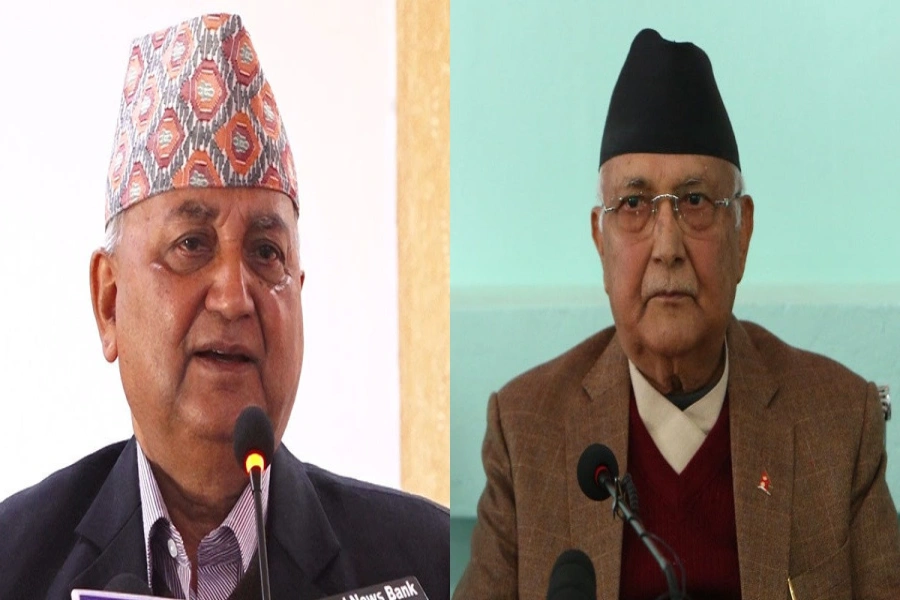It would be a litmus test for Nepal to maintain and continue its age-old non-aligned foreign policy in case any emerging regional super power presses her and forces her to oblige them with a strategic partnership. Tilting against the other with a security alliance would be a blunder for its survival. There could possibly be a Himalayan Triangle, a formation of three nations China, Pakistan, and Afghanistan, rather than a Himalayan Quadrangle with the inclusion of Nepal.
‘Nepal and China are separated by mountains but linked by rivers’ is a phrase usually pronounced when Nepal-China relations are mentioned. Citing historical aspects of the relationship, until a few years ago, the Chinese officials used the term “Nepal China friendship based on comprehensive partnership and everlasting friendship,” but this has now been upgraded to a strategic level. During an official visit of the Chinese President Xi Jinping to Nepal in 2019, at a time the Communist Party of Nepal was at the helm of governance with an absolute majority in the House of Representatives, the level of friendship was elevated as a “strategic partnership based on everlasting friendship and comprehensive partnership,” which apparently stated the desire of China to include Nepal in its geo-strategic realm.
In order to secure its strategic interest, China created Shanghai Cooperation Organization, primarily with the security-related concern in Central Asia with five members - China, Kazakhstan, Kyrgyzstan, Russia and Tajikistan. It has now eight members including Uzbekistan, India and Pakistan. India and Pakistan became its full member in 2017. Nepal was granted membership as a dialogue partner in 2015. From the very beginning of its inception, the organization was destined to look into the matters of collective security, and political and economic well-being of its member states. The enlarged membership with the inclusion of India and Pakistan is more inclined to prioritise and give emphasis on geographical and peripheral reach, each member country having border connection with China, to protect and promote the strategic interests of its member states.
Despite India being its member, China and India soured their relations after they had a brief faceoff in their disputed Himalayan region in Galwan and Docklam Valley. In June 2020, India lost its 20 soldiers in a clash over border row at Pangong Tso in the Galwan Valley while facing off against Chinese troops. India also had skirmishes with the Chinese troops in the Docklam, an area of Bhutan located near the tri-junction of China and India, in the Eastern part of Himalayan range bordering the Sikkim state.
China also has a common border with Pakistan and Afghanistan. Since Pakistan claims it has an all-weather friendship with China, there is no doubt that it has a close bond and strategic partnership. Under the CPEC program, China has hugely invested its money for developing connectivity with Pakistan and beyond it by a Karakorum highway, and Gwadar Port in West Pakistan. Having Pakistan by its side as a trusted friend, China also has the reason to be worried for its strategic interest in Xinjiang Uyghur because of rising Islamic fundamentalism.
Afghanistan is a new Himalayan frontier for China after the US and NATO alliance troops left it under their peace deal, but a hotspot for Islamic fundamentalist Taliban to take over the ruins and rule by Islamic code. Afghanistan due to its geographical position, however landlocked, holds strategic importance as a gateway to Central Asia and beyond and therefore all the major powers would like to have their influence and hold on it. There probably would be a tripartite race between Russia, China and India trying their best to fill the power vacuum created by the absence of the American alliance.
Trans-Himalayan self-drive on vintage cars

A power vacuum looms large after the US military mission left Afghanistan posing security risk in the region. In such a fluid situation across the mountains, China has come up with an idea of forming a Himalayan Quadrangle Similar to that of the US-led Quad. The proposed Himalayan Quad is the culmination of a Chinese policy initiative for a geo-strategic counter against the encirclement policy of the Indo-Pacific Strategy.
There has been mounting pressure in Kabul to maintain its strong hold against the militant force marching forward occupying the large swath of territories. After the complete withdrawal of American and its alliance NATO troops from Afghanistan, the conventional, religiously-indoctrinated conservative firebrand, the Taliban, gained control over Kabul. In such a situation, cultivating relationships on a new footing is required for China to take its hold in Afghanistan, where the competing regional power India also has its stake in claim as it has invested huge amounts in several developmental projects. Without bringing Afghanistan in China’s ambit of influence as of Pakistan, it is a mission impossible for China to form a Himalayan Quadrangle.
It seems Afghanistan as a hotspot for decades with their strategic interests of major global powers, first the USSR, then the United States and now, possibly, the rising power China is vying for filling the vacuum, which because of the resentment and animosity that Taliban harboured for so many years against the American foothold in Afghanistan may push it toward China’s sphere for a strategic alliance.
Making inroads into South Asia, developing connectivity among the nations and trans-Himalayan countries have become the hallmark of Chinese foreign policy initiatives lately in its quest to connect with South Asia as a policy priority politically, economically and strategically. Its heavy investment in Pakistan under CPEC and railway and fibre optical construction projects in Afghanistan are some of its initiatives, which is often referred to as a “handshake across the Himalayas.” China has an eye on extracting the largest copper deposits at MesAynak. Building the Trans Himalayan Railway, with regard to Nepal, is also included within the strategic interest of China.
The issue of Himalayan Quadrangle sprouted up at a time while commemorating the centenary of the Chinese Communist Party, the Government of China established a “China-South Asian Countries Poverty Alleviation and Cooperative Development Centre” in Chongqing City with the objective of extending support to South Asian countries in order to alleviate poverty through integrated approach.
With the commencement of this organization and China’s attempt to expand its wings through such institutions at a time when the SAARC process is stalled, it is understandable that China wants to consolidate its strategic hold in South Asia by using all available means and methods applicable thereof. It has been articulated that the establishment of this organization is primarily estimated to give counter to the South Asia Association for Regional Cooperation. The SAARC’s 19th summit which was scheduled to be held in Islamabad in 2016 has been stalled for years after its 18th summit held in Kathmandu in 2014.
With the establishment of such an organization, China is bound to proceed with the economic packages, an extension of its wing as soft power. But China’s concern without the presence of India seems more of a strategic significance than of necessity. Evidently, China wants in this forum the countries which are members of BRI.
With regard to Nepal, its quest to open all the possible avenues for maintaining strategic leverage over it, through enhancing the border connectivity at first and opening up the trade and transit facilities later is an instrument to this end. Opening of connectivity with China and means of transport through several border points is the necessity of Nepal and needs to be evaluated with the background of the economic blockade imposed by India by closing its borders not once but four times, in 2019, 2027, 2045, and 2072 BS, in the modern history. Nepal had undertaken immense economic hardships as a punishment impinged upon it by India, not for its mistakes but for not dancing to the tune of India.
Needless to say, such institutions are built and power centres are created in order to maintain regional and international strategic geo-political balance. As a landlocked country with several developmental constraints, it is desirable to get benefits and utilise it with positive vibes for the larger benefits of fulfilling national interests. For this, Nepal needs to devise a proper planning on utilising the forum extracting best results out of it for the national benefits.
But becoming a member of a development forum and forming partnership with a strategic alliance are different things. China’s attempt to form a Himalayan Quadrangle may have its significance from its own perspective, but its repercussions on Nepal may fall profoundly. However, with regard to Nepal’s perspective, collaborating partnership with strategic interest and becoming a member of regional power block is a matter to ponder seriously, where a misstep could end up as a blunder.
China’s attempt to counter India by creating an institution in parallel and similar to the model of SAARC has the strategic significance with its objective of getting a stronghold in South Asia along with its BRI projects. It is also called the Northern Himalayan Quad similar to that of the US-led Quad (Quadrilateral Security Dialogue), where India is an active member along with Japan and Australia.
The formation of Quad is an attempt of the amalgamation of American, Japanese, Australian and Indian interests to contain and encircle China for its expansionist actions basically in the Asia Pacific Region. Since Quad has its geo-strategic significance primarily on maritime safety for secured trade and transit, it also carries the geo-political spheres as well.
Many security experts believe that China may insist Afghanistan, Pakistan, and Nepal to be a member in its Quad initiative. At such an occurrence, at the diplomatic front, Nepal may face huge challenges to maintain balanced relations with its neighbors. The friction between the two big neighbors will have consequences that may fall upon Nepal.
Undeniably, Nepal needs to reap the benefits from the rise of its neighbors, but it requires to carefully indulge in the projects which have fewer political consequences than more benefits accruing out of it in economic terms. While selecting the mode of transportation in a process of developing connectivity, integrated infrastructures at the borders along with all-weather access to our borders, Nepal also needs to pay attention to the economic viability, affordability and sustainability in the long run.
It would be a litmus test for Nepal to maintain and continue its age-old non-aligned foreign policy in case any emerging regional super power presses her and forces her to oblige them with strategic partnership. Tilting against the other with a security alliance would be a blunder for its survival. There could possibly be a Himalayan Triangle, a formation of three nations China, Pakistan and Afghanistan, rather than a Himalayan Quadrangle with the inclusion of Nepal. It would be in the best interest of Nepal to remain aloof without a security alliance.








































